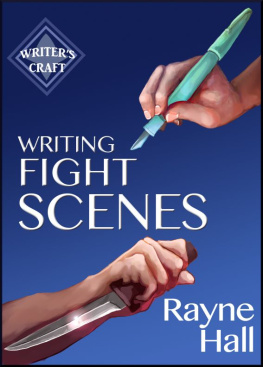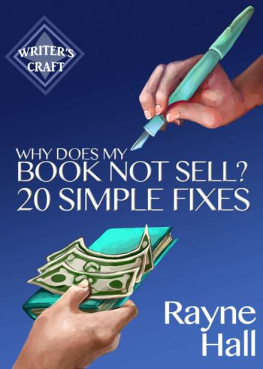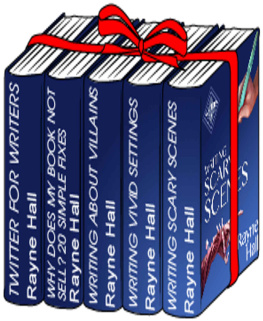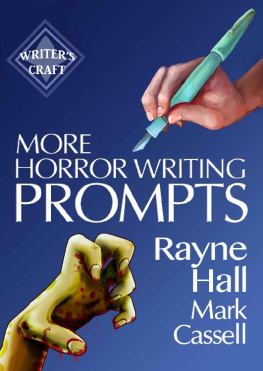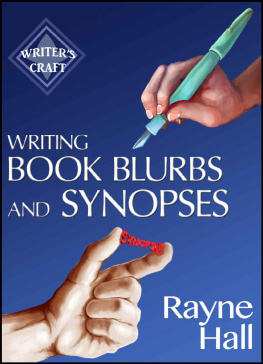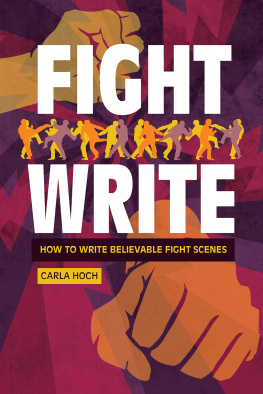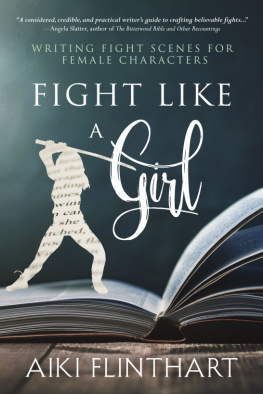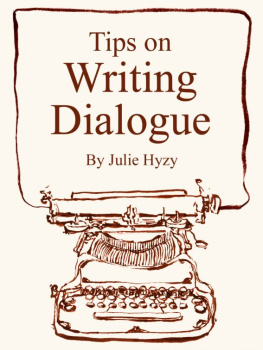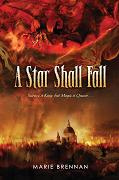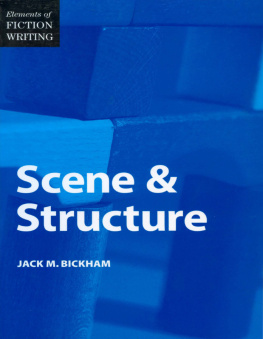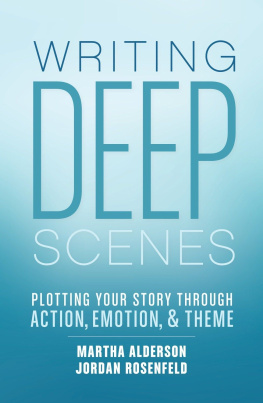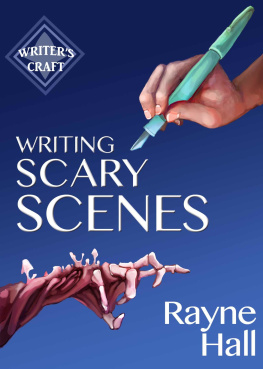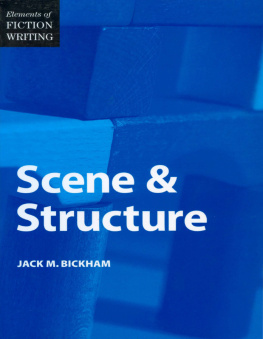WRITING FIGHTSCENES
by
RAYNEHALL
Copyright 2011-201 4 Rayne Hall
All RightsReserved
Cover Artand Design by Erica Syverson
Scimitar Press
January2014 Smashwords Edition
This ebook islicensed for your personal enjoyment only. This ebook may not bere-sold or given away to other people.
CONTENTS
The gritty fightscene and the entertaining fight scene. Blending entertainment andgrit. Which style for which genre? How much violence does a fightscene need? Blunders to avoid.
Use the setting toadd entertainment, realism and suspense. Blunders to avoid.
A blueprint foryour scene in six parts: Suspense, Start, Action, Surprise, Climax,Aftermath.
Three main types:thrusting, cleaving and slashing. Blunders to avoid.
Dagger or knife?Concealment. Connotations. Fighting techniques. Blunders toavoid.
Thrusting andthrowing spears. Poleaxes, billhooks, halberds. Blunders toavoid.
Historicalclubbing and cleaving weapons. Archery. Blunders to avoid.
Three main types:rifle, handgun, shotgun. Blunders to avoid.
What a resourcefulcharacter may use at a pinch, and why readers love it.
Inventing aplausible magical weapon. How to defeat a magician. Magicalwarfare. Blunders to avoid.
Hand-to-handfighting. Two types: grappling and striking martial arts. Inventinga fantasy martial art. Who wins? Blunders to avoid.
Why readers loveself-defence scenes. Self-defence for the skilled martial artists.Self-defence ideas the inexperienced fighter. Blunders toavoid.
How much strength,skill and strategy do fighters need, and where do they get them?Blunders to avoid.
Reluctance tofight. Reality shock for martial artists. The 'freeze'.
Readerexpectations. Physical and psychological differences. Skills andbackstory. Inexperienced female fighters. Different fightingstyles. Female curves of arousal. Women and weapons. Femalesoldiers. Clothing and armour. Blunders to avoid.
Characteristicmale dialogue and body language. Skills. Men and their weapons.Male curves of arousal. Men against women. Blunders to avoid.
How animals fight.Writing from an animal's point of view. Were animals. Animals asweapons: dogs, horses, elephants. Fighting against an animal.Blunders to avoid.
Purpose andmotivation. Raising the stakes. Emotion. Stacking the odds.Manipulate the reader's instincts. Blunders to avoid.
Deep point ofview. Using the senses: which sense in which part of the fight?Blunders to avoid.
Historical andmodern armour. Shields. Blunders to avoid.
Brawl. Duel.Ambush. Assassination. Riot.
Managing the pointof view and reader sympathies. How to make a one-against-many fightplausible. Blunders to avoid.
Plotting andstructuring a battle scene. Blunders to avoid.
Active and passivesiege warfare. Blunders to avoid.
Tips for piratefights and naval battles. Destroy, plunder or capture? Boat orShip? Blunders to avoid.
Tips for romance,humour, fantasy, horror, thriller, mystery, historical literary,young adult and children's fiction.
Hand-to-handfighting. The erotic connotations of daggers. Male fantasies offemale fighters. Post-fight horniness.
The big fightbetween the hero and the villain at the end of the book. Blundersto avoid.
Tricks for fastpace. Word choices and sentence structures. When and how to slowthe pace. Blunders to avoid.
Subtle techniquesfor creating a mood of foreboding, fear, hard action, defeat orvictory.
How to make itsound real. Witty zingers. Catchphrases. Blunders to avoid.
Tunes to put youin the mood.
Where to find outmore.
Two fight scenes by Rayne Hall: excerpts from Storm Dancer and Scylla and thePepper Pirates.
This book willhelp you to write a fight scene which is entertaining as well asrealistic, and leaves the reader breathless with excitement.
You may beclueless about fighting matters, as many authors are. The book willshow you step-by-step to write plausible fights and avoidblunders.
On the other hand,you may be a skilled martial artist, a military historian or acombat veteran. Then the book will guide you to turn your knowledgeinto vivid fiction.
I'll give you asix-part structure to use as blueprint for your scene, and revealtricks how to combine fighting with dialogue, which senses to usewhen and how, and how to stir the reader's emotions. You'll decidehow much violence your scene needs, what's the best location, howyour heroine can get out of trouble with self-defence and how toadapt your writing style to the fast pace of the action. There willbe sections on female fighters, male fighters, animals and weres,psychological obstacles, battles, duels, brawls, riots and finalshowdowns. For the requirements of your genre, there is even adviceon how to build erotic tension in a fight scene, how magiciansfight, how pirates capture ships and much more. You will learnabout different types of weapons, how to use them in fiction, andhow to avoid embarrassing blunders.
A few years ago,when I struggled with my fight scenes, I looked for guidance andfound none. So I set about discovering for myself what makes agreat fight scene. I studied famous fight scenes in classicliterature and in modern thrillers, observed their structure andanalysed their techniques. Armed with these insights, I wrote fightscenes which enthralled the readers. Before long, other writersasked me to help me improve their fights. From there, it was asmall step to teaching online classes in Writing Fight Scenes. Allthe time, I continued studying the subject and adding to myknowledge.
When I look backon my early fight scene attempts, I cringe - the mistakes are soglaring, the structure so awkward, the style so embarrassing. Now Iknow how to make a fight scenes work, and I want to share thesetechniques with you.
My expertise liesin the craft of fight scene writing, not in fighting. I'm a writer,not a warrior. A real fighter could easily beat the crap out of me.I could write a really good scene about it afterwards.
Although I'vetrained in several martial arts forms (mostly kickboxing, someself-defence, a little karate and aikido, even a spot ofprofessional wrestling), I haven't won any match trophies or earnedany black belts. My real-life fighting experiences includedefending myself against a lecher in a rowing boat by hitting anoar over his head, and chasing away the neighbourhood bully with agarden spade.
When it comes toweapons, I know quite a bit about ancient arms and armour. Icollect ancient arrowheads, and have flint-knapped my own set ofstone age weaponry. I've practised archery (with considerablesuccess), spear-throwing (so-so), and stone-slinging (abjectfailure).
As a belly dancer,I had an act where I balanced five blunted swords on differentparts of my body. Although the weight of the swords led to hellishpain in my joints, audiences loved the show.
I've choreographedsword and staff fights for stage performances. While stage fightsare very different from real fights, they have a lot in common withfight scenes in fiction.
The chapters giveadvice for different types of fights, weapons and genres, some ofwhich will be relevant to your story and some won't. Simply skipwhat you don't need.
This is a bookabout the craft of writing. It won't turn you into militaryhistorian or weapons expert, and it won't teach you how tofight.
While you don'tneed fighting experience to use this book, you need a basicunderstanding of the writing craft. If you're a beginner, Irecommend you study a book on general fiction techniques first.
I'm using BritishEnglish. If you're used to American English, some of the words andspellings may look odd, but I'm sure you'll understand meanyway.
When talking aboutcharacters, I'll use 'she' sometimes and 'he' at other times. Withthe exception of Chapters 15 and 16, almost everything I sayapplies regardless of gender.

